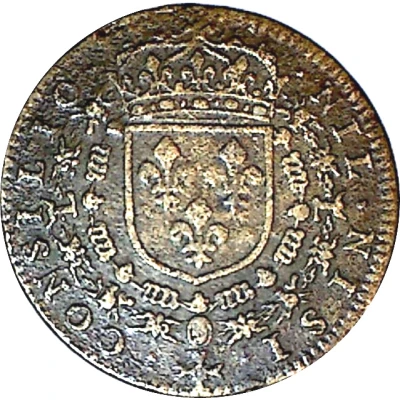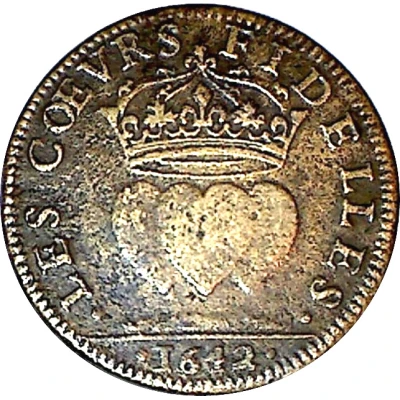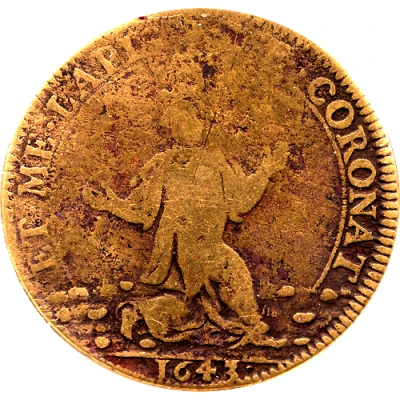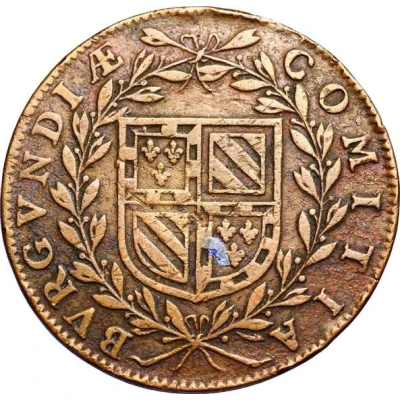
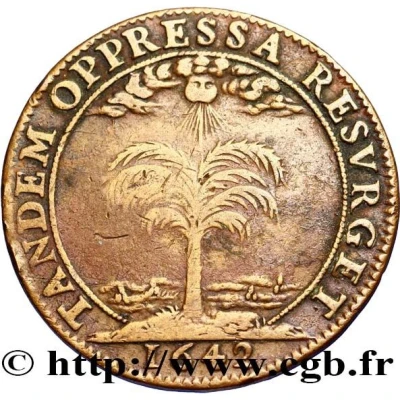

© CGB
Token - Louis XIII - États de Bourgogne - Tandem oppressa resurget
1642 year| Copper | 7.9 g | 30 mm |
| Location | France |
|---|---|
| King | Louis XIII (1610-1643) |
| Type | Commemorative medals › Company, institution and association medals |
| Year | 1642 |
| Composition | Copper |
| Weight | 7.9 g |
| Diameter | 30 mm |
| Shape | Round |
| Orientation | Coin alignment ↑↓ |
| Demonetized | Yes |
| Updated | 2024-11-12 |
| Numista | N#50581 |
|---|---|
| Rarity index | 97% |
Reverse
In the background, a landscape; in the foreground, on a piece of land extending beyond the field into the circle of legends, an eight-branched palm tree, set under a cloudy sky from which emerges a sun depicted in the form of a human face blowing its rays; date in the exergue.
Script: Latin
Lettering:
TANDEM OPPRESSA RESVRGET
1642
Unabridged legend: Tandem oppressa resurget.
Edge
Plain
Comment
The province [of Burgundy] was obliged, despite its protests, to give a further 60,000 livres for the garrisons on the borders, Auxonne, Bellegarde, St-Jean-de-Losne, Verdun, St-Seine-sur-Vingeanne, Fontaine-Française, Mirebeau, Bletterans and other places situated between Franche-Comté and Burgundy. This affair was hotly debated; it had been discussed in the Council at the home of Cardinal de Richelieu; the King had made the country responsible for its places, and told the Elected Officials that, if they didn't obey, he would make them obey him.Finally, in 1642, the two provinces, exhausted by the passage of troops and garrisons, agreed to a neutrality that halted for some time the constant attacks on each other by the border towns of the two Burgundian regions. Our States then believed that they had reached the end of their sacrifices, and minted this token: the province is represented by a palm tree whose branches will rise again under the influence of the sun. But it's still just a wish: RESURGET. It's a hope, a future like the OCCIDENT of the previous triennium. The present is MALA, it's OPPRESSA, expressions that cry out loud and repeat the OBRUIMUR of 1634.
Indeed, the situation was hardly any better, despite the TANDEM, which alluded to the resumption of neutrality between the two provinces. At the opening of the Estates of 1642, the Duc d'Enghien had said: "There is no other way than to wage war: the pride of the superb nation must be brought down.... His Majesty's designs are enlightened by the incomparable advice of M. Cardinal de Richelieu, for the honor of France and the shame of those who wish to invade the universal monarchy."
"We must therefore wage war," Brulard continued; "the longer the war, the more lasting the peace... The great Cardinal said he would bring the House of Austria so low, that in a hundred years it could not rise again."
While we were fighting on the outside, they were conspiring on the inside; that's when Cinq-Mars and de Thou had their heads cut off, the latter for not having said anything about the conspiracy the other was plotting against France.
However, the re-establishment of neutrality between the two provinces was something of a relief for Burgundy, as the garrisons required for hostilities were a heavy burden for both sides, not only because they had to be maintained, but also because they invaded each other's provinces. Thus, during the 1642 meeting of our two States, the Gray garrison made an excursion to the banks of the Vingeanne, which it crossed. After avoiding Mirebeau by passing over Bèze, it reached the walls of Dijon, ravaging and pillaging the villages and hamlets it encountered along the way. Epagny, Savigny-Ie-Sec, Marsannay and Flacey, which it found in its retreat, lost their livestock, and the best part of the inhabitants were captured and taken to the Emperor's lands.
Claude Rossignol, Des libertés de la Bourgogne, d'après les jetons de ses États (1851).
